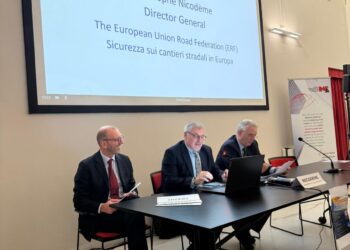The main conclusions of the Benchmark study conducted in 11 European countries

8 September 2021 | Brussels
The European Union Road Federation (ERF), the Confederation of International Contractors’ Associations (CICA), the French Federation for Public Works (Fédération Nationale des Travaux Publics – FNTP), the European Construction Industry Federation (FIEC) and Routes de France have joined forces to produce this benchmark study entitled “Mobility and Recovery in Europe: Impacts of the Covid-19 crisis”.
The aim of the study is to give a picture, in 11 European countries (*) of the impact of the crisis caused by the pandemic on the mobility and transport sectors. The approach is to compare the evolution of mobility before and after the arrival of the health crisis. In addition, it will analyse the way in which European countries have adapted their support for transport infrastructures, further to an analysis of national recovery and resilience plans, based on the European Recovery Plan (“Next Generation EU”).
The main trends observed:
- Electromobility and replacement of the public and private fleet with electric and alternative fuel vehicles
The use of electricity in mobility and transport is strongly encouraged in all stimulus packages, with the aim of reducing the carbon footprint of one of the sectors responsible for a significant share of emissions. This shift towards electromobility concerns both passenger and freight transport.
- Emphasis on public transport in the urban context, to replace private cars, and development of cycling infrastructure
The underlying logic of all the national recovery and resilience plans is to shift the modal split from one that is still essentially based on the private car to collective modes of transport and alternative or shared mobility. Investments and reforms are therefore geared towards this goal.
- A strong focus on railways, especially for freight transport
Rail is the main infrastructure targeted by the stimulus packages. The extension, reinforcement, and maintenance of railways, as well as the purchase of new trains, are the main investments in this area. The main aim of these interventions is to change the modal split of freight transport, which still relies mainly on road transport.
- Incentives to reduce private car use in line with existing national policies
In general, investments in public transport development go hand in hand with measures to reduce solo car use, especially in the urban context. This is mainly done through reforms and the establishment of car-free zones in city centers. This trend was already underway before the pandemic, especially in European capitals and large urban centers.
- Digitalisation of infrastructure and 5G deployment
Strongly encouraged by the European Commission, the deployment of the 5G network is a priority in several national recovery plans. A general trend towards digitilisation of infrastructure is observed in most European recovery plans, particularly for rail services.
- Hydrogen development
When it comes to research and innovation applied to transport and mobility, hydrogen is clearly the priority technology. Many Member States are planning to use a significant part of their European Recovery Plan budget both for research and for the development of infrastructure necessary for the implementation of hydrogen use in transport.
- Simplification reforms for public procurement and public works
As a precondition for receiving European Recovery Plan funds, some administrative and regulatory reforms are envisaged by Member States. In relation to the public works sector, many of the national recovery and resilience plans mention the introduction of simplified tendering procedures to speed up projects’ implementation.
- The minimal place of road infrastructure in national recovery strategies
The road network is probably the most neglected infrastructure among the national recovery strategies. Almost no investment is mentioned, either in the construction of new roads or for maintenance. The only investments that imply an intervention on roads are strictly related to digitalisation.
(*) Belgium, Croatia, Czech Republic, France, Germany, Italy, Netherlands, Poland, Spain, Sweden, United Kingdom
|
Main recommendations
Even with massive incentives and policies in favour of public transport and rail, road transport will remain predominant for the movements of goods and people, even though it will benefit from major changes in favour of the decarbonisation of vehicles and the deployment of active mobility.
To serve the recovery of the economy, employment and the objectives of the Green Deal, European countries must intervene with actions targeted at maintenance and rehabilitation through simplified procedures. This would enable road infrastructure, which has been largely neglected by the investments and policies of the last ten years, to catch up, particularly to support the ecological, digital and energy transitions.
|
The report can be found HERE
For further information:
The European Union Road Federation (ERF) represents the interests of the road infrastructure sector towards the European Institutions.
Contact : c.nicodeme@erf.be.
Routes de France brings together French companies involved in the construction, development and maintenance of road infrastructure
Contact : jean-baptiste.depremare@routesdefrance.com.
The French Federation for Public Works (Fédération Nationale des Travaux Publics – FNTP), through its 12 regional federations, brings together 8,000 companies involved in public works and represents 300,000 employees.
Contact : gaubertn@fntp.fr.
The European Construction Industry Federation (FIEC) (Fédération de l’industrie européenne de la construction – FIEC) brings together 33 national construction federations in 29 European countries.
Contact : k.thies@fiec.eu.
The CICA (Confederation of International Contractors’ Associations) represents the interests of the construction sector worldwide.
Contact : a.canton@cica.net.
-
Safer, Smarter Roads Discussed at the 25th Belgian Road Congress
October 10, 2025 -
ERF calls for Smarter, Safer Road Work Zones at Bologna Forum
October 9, 2025




